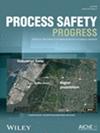Collection and analysis of hydrocarbon gas buried onshore pipeline accidents in Indonesia as the databases for failure frequency assessment in a quantitative risk analysis
IF 1
4区 工程技术
Q4 ENGINEERING, CHEMICAL
引用次数: 0
Abstract
As of May 31, 2022, approximately 18,687 km of gas pipeline has been built in Indonesia. However, the pipeline failure data are yet to be gathered or evaluated. In quantitative risk assessment (QRA), the pipeline failure frequency is calculated by a generic failure frequency approach. Most of these generic failure frequency data are based on other region pipeline incident databases. This paper aims to provide the basis of data for the failure frequency of Indonesia's buried onshore pipeline. Accident data from 1127.9 km of underground onshore gas pipelines within 30 years (1976–2006) in Indonesia were gathered and assessed to provide the cause and effect of pipeline age and diameter on the generic failure rate. This research reveals the average failure rate of 5.32E-04/km-year of onshore pipelines in Indonesia. The study concluded that baseline failure frequencies from this analysis could be used for buried onshore pipeline quantitative risk assessment purposes. Further pipeline failure research for a relatively current period (e.g., from 2006 to 2022), type of installation (e.g., buried, or non-buried), and other applications of the pipeline (e.g., offshore pipeline) should be conducted as a way forward for this study to have a complete database for Indonesian accidents.收集和分析印度尼西亚碳氢化合物天然气埋地陆上管道事故,作为定量风险分析中故障频率评估的数据库
截至 2022 年 5 月 31 日,印度尼西亚已建成约 18,687 公里的天然气管道。然而,管道故障数据尚未收集或评估。在定量风险评估 (QRA) 中,管道故障频率是通过通用故障频率法计算得出的。这些通用故障频率数据大多基于其他地区的管道事故数据库。本文旨在为印尼陆上埋地管道的故障频率提供数据基础。本文收集并评估了印度尼西亚 30 年内(1976-2006 年)1127.9 公里陆地地下天然气管道的事故数据,以提供管道年龄和直径对一般故障率的影响。研究显示,印度尼西亚陆上管道的平均故障率为 5.32E-04/公里-年。研究认为,该分析得出的基准故障频率可用于陆上埋地管道定量风险评估。应针对相对较近的时期(如从 2006 年到 2022 年)、安装类型(如埋地或非埋地)以及管道的其他应用(如海上管道)开展进一步的管道故障研究,以此作为本研究拥有完整的印尼事故数据库的前进方向。
本文章由计算机程序翻译,如有差异,请以英文原文为准。
求助全文
约1分钟内获得全文
求助全文
来源期刊

Process Safety Progress
工程技术-工程:化工
CiteScore
2.20
自引率
10.00%
发文量
99
审稿时长
6-12 weeks
期刊介绍:
Process Safety Progress covers process safety for engineering professionals. It addresses such topics as incident investigations/case histories, hazardous chemicals management, hazardous leaks prevention, risk assessment, process hazards evaluation, industrial hygiene, fire and explosion analysis, preventive maintenance, vapor cloud dispersion, and regulatory compliance, training, education, and other areas in process safety and loss prevention, including emerging concerns like plant and/or process security. Papers from the annual Loss Prevention Symposium and other AIChE safety conferences are automatically considered for publication, but unsolicited papers, particularly those addressing process safety issues in emerging technologies and industries are encouraged and evaluated equally.
 求助内容:
求助内容: 应助结果提醒方式:
应助结果提醒方式:


